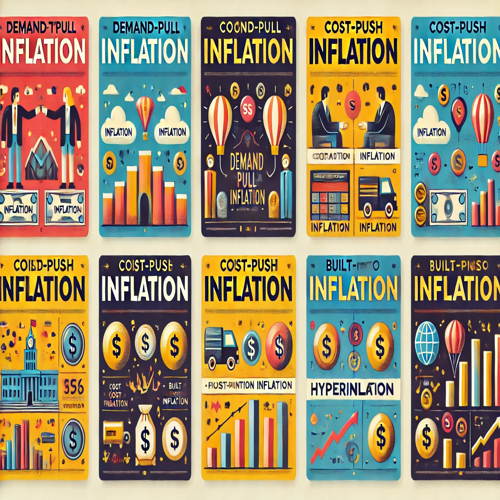
What is Inflation? Types of Inflation, Core Inflation…
What is Inflation? Types of Inflation, Core Inflation, Supply inflation, Demand Inflation, Built-in inflation…
Definition of Inflation and Different Concepts, Types of Inflation
Inflation refers to a continuous and steady increase in the general prices of goods and services in an economy. This economic phenomenon is defined as the increase in the price level in a given period compared to the previous period. Although inflation is often confused with the concepts of “price increases” and “cost of living”, they are distinct. While inflation refers to the rise in the prices of all goods and services in general, price inflation refers to the rise in the price of a particular good or service. The cost of living, on the other hand, is the situation where the income earned lags behind the rise in prices. Read more for types of inflation.
Causes and Effects of Inflation
Inflation can be defined as a continuous increase in the general price level of goods and services. It occurs when prices rise steadily throughout the economy. Inflation should not be confused with an increase in the price of a single product or a one-off price rise. Large and persistent price increases in the economy are called inflation. The answer to the question of why inflation increases can be explained by various factors, such as supply and demand imbalances, increases in production costs and expansions in the money supply.
Types of Inflation
Demand Inflation: Increase in the Shadow of Economic Revival
Demand inflation is a type of inflation that occurs as a result of the increase in consumption with the increase in money supply. Prices rise when the demand for goods and services produced and imported in the economy exceeds the current production and import volume. This situation is usually observed during periods of economic growth. In periods of economic revival and rising income levels, an increase in consumer spending is observed. However, production may not increase rapidly enough to meet this increased demand. Measures to increase production, such as investments, hiring new workers and additional overtime, lead to an increase in production costs. These cost increases, in turn, lead to higher prices. Demand inflation is unsustainable in the long run. Continuous high demand may cause inflation to increase uncontrollably. Therefore, the economic management resorts to various monetary policy instruments to keep demand inflation under control. Measures such as increasing interest rates and controlling money supply are among the methods used to rein in demand inflation. These dynamics explain the relationship between demand inflation and economic growth and the measures taken by the economic management to stabilise this situation.
Supply inflation: Price Increases due to Higher Production Costs
One of types of inflation is supply inflation, also known as cost inflation, is the rise in prices due to increases in the cost of materials and labour used in production. This type of inflation is associated with cost increases in the production process rather than demand-side factors. There are several factors that lead to cost inflation. Continued increases in labour costs, rising tax burdens on companies and rising raw material prices all push up production costs. In addition, the increase in the price of imported goods and services due to the rise in exchange rates also contributes to cost inflation. All these factors increase producers’ costs, and these cost increases are reflected in the prices of final products. Supply inflation is caused by disruptions in the production process or increases in costs and is generally more difficult to control than demand inflation. In order to control supply inflation, economic authorities usually need to take broader measures, such as fiscal and structural reforms, as well as monetary policy instruments.
Built-in inflation: The impact of Expectations on Inflation
Anchored inflation, or inflation expectations, refers to the effect on inflation of consumers’, firms’ and market participants’ forecasts of future inflation. Expectations of rising inflation lead to a wage-price spiral, which is an economic cycle. This situation leads workers to demand that the expected rise in inflation be reflected in their wages. When employers have to meet these demands, they experience an increase in their costs. Higher costs are reflected in the prices of goods and services, leading to higher inflation. This cycle can lead to inflation feeding on itself and rising continuously. Embedded inflation is crucial for managing expectations. Economic authorities use various communication strategies and monetary policy instruments to manage inflation expectations. In this way, they try to prevent inflation expectations from influencing actual inflation rates.
Core Inflation: A Measure That Reflects the Underlying Price Trends in the Economy
One of types of inflation is core inflation, is a more stable measure of inflation that aims to reflect underlying price trends while minimising the impact of short-term fluctuations in the economy. This measure is generally less sensitive to temporary effects and better reflects the long-term price movements in the economy. While core inflation is derived from headline inflation indicators such as the consumer price index, it is calculated without taking into account volatile price components such as energy and food. As the prices of these volatile components change frequently, core inflation excludes these fluctuations and thus provides a more consistent picture of inflation. Core inflation is an important tool for central banks and economic analysts when making economic policy decisions. Because it excludes volatile components such as energy and food prices, it reflects longer-term trends in the economy. This helps policymakers to better understand inflation and develop appropriate economic policies. Core inflation stands out as a more stable and reliable inflation indicator that is taken into account in economic analyses and policy decisions.
© 2023 Brokerscenter, All Rights Reserved.



